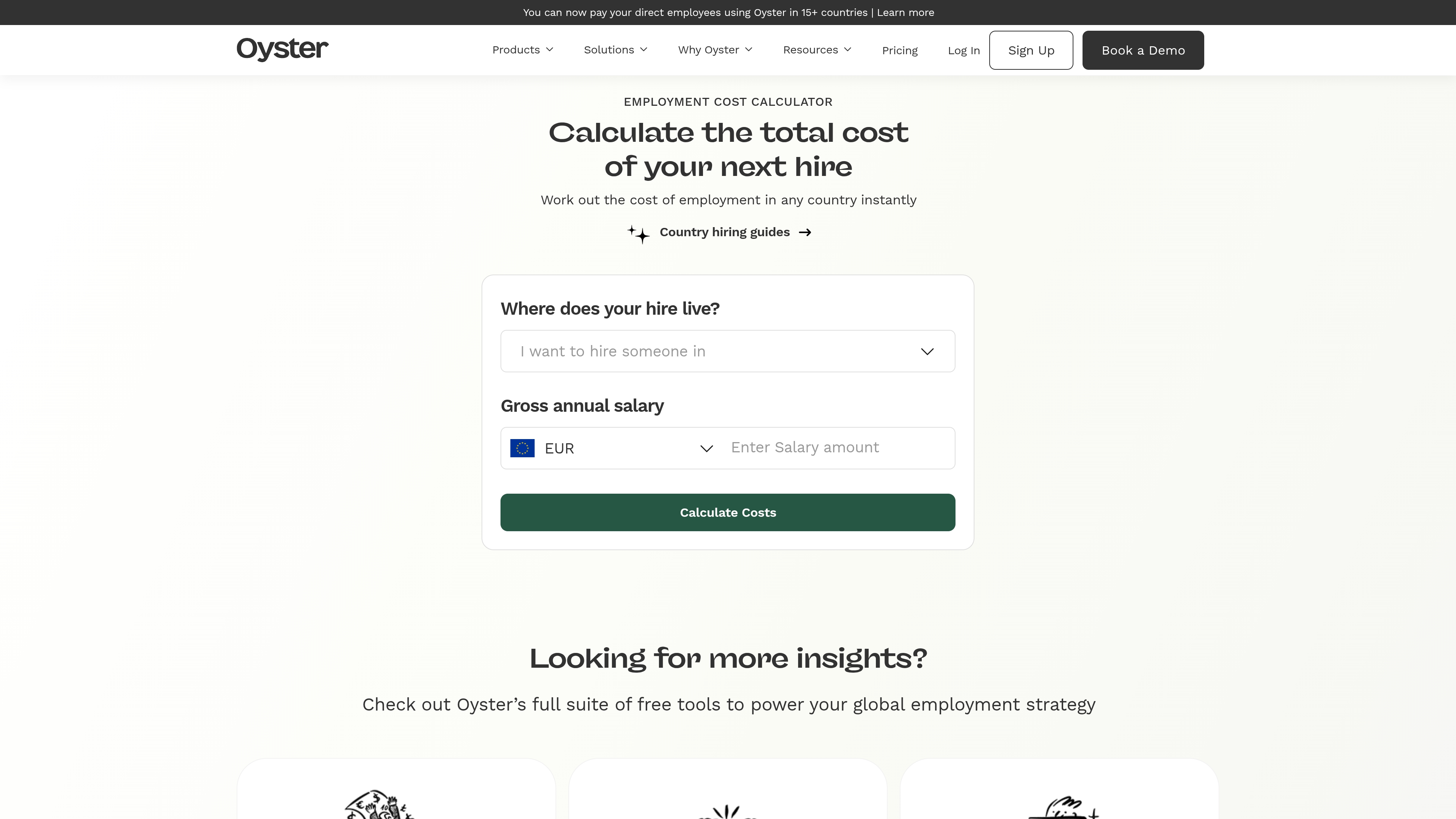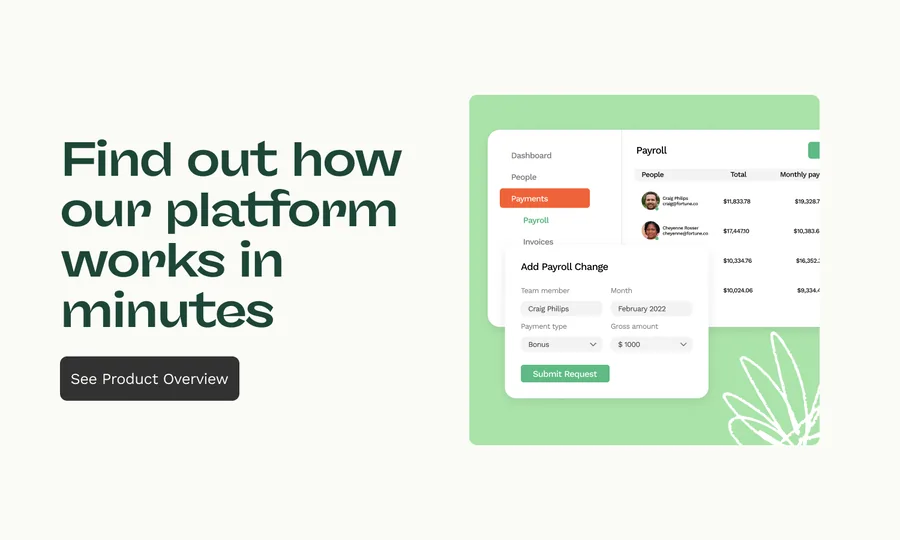What is HR management software?

HR management software
HR management software refers to digital solutions designed to streamline and centralize HR tasks, as demonstrated by one company's successful project to digitalize all employee data for 10,000 employees across 40 countries in just eleven months. It automates routine activities like payroll processing, talent acquisition, and employee performance tracking.
By integrating various functions—such as benefits administration, time and attendance, and workforce analytics—into a single platform, this software enhances efficiency and facilitates data-driven decision-making. The adoption of this technology can help businesses remain compliant, competitive, and capable of managing a diverse, evolving, and often distributed workforce.
Interested in Oyster but want more information about how the platform works? This product overview should help.
Types of HR management software
HR management software comes in three main types: HRIS (Human Resource Information System), HRMS (Human Resource Management System), and HCM (Human Capital Management). Each type offers different levels of functionality, from basic data management to comprehensive workforce planning.
- Human Resource Information System (HRIS): Think of this as the foundation. An HRIS is used to manage core People Ops data, like Team Member information, compliance documents, and reporting.
- Human Resource Management System (HRMS): An HRMS includes everything in an HRIS but adds more robust features for talent management. This often includes payroll and benefits administration, as well as time and attendance tracking.
- Human Capital Management (HCM): This is the most comprehensive category. HCM software covers all HRIS and HRMS functions and adds strategic capabilities like global workforce management, compensation planning, and performance management.
Key features of HR management software
A modern HR management platform centralizes the most critical People Ops tasks, saving time and reducing errors. While features vary, here are some of the most common capabilities to look for:
- Payroll and compensation: Automates salary calculations, tax withholdings, and payments in multiple currencies.
- Benefits administration: Manages enrollment, contributions, and compliance for health insurance, retirement plans, and other local benefits.
- Onboarding and offboarding: Streamlines the process of bringing new Team Members on board and managing departures with clear, repeatable workflows, which is crucial for meeting compliance requirements like the need to report their new employees to state directories within 20 days of their hire date.
- Time and attendance tracking: Simplifies tracking work hours and managing time-off requests and approvals.
- Performance management: Provides tools for setting goals, conducting reviews, and giving continuous feedback to support Team Member growth.
- Reporting and analytics: Offers insights into headcount, turnover, payroll costs, and other key metrics to inform strategic decisions.
The benefits of using HR performance management software
So, what are the actual benefits of HR management software for growing teams? The advantages are pretty compelling.
Performance improvement: The software creates a structured platform for setting objectives and giving real-time feedback. This ongoing assessment helps identify areas for improvement and boosts overall team performance, with Gallup research showing that the most engaged teams demonstrate 23% higher profitability than the least engaged teams.
Time savings: Automated processes for goal-setting, appraisals, and performance tracking eliminate cumbersome paperwork. This frees up your People Ops team to focus on strategic work.
Better decision-making: Comprehensive analytics help you spot patterns and trends you might miss otherwise. The insights are invaluable for:
- Recognizing top performers
- Identifying skill gaps
- Planning strategic workforce moves
Compliance support: Built-in features help you navigate labor law complexities—such as the IRS requirement to keep records of employment taxes for at least four years—and reduce legal risks.
Transparency and accountability: When Team Members can access their performance data, it creates a culture of continuous improvement—a critical benefit when you consider that only 21% of employees worldwide are engaged at work. People take charge of their own development when they have clear visibility into their progress.
How to choose the best HR management software
Selecting the best HR management software is a decision that can significantly impact an organization's efficiency, compliance, and employee engagement.
With various options to choose from, the process can seem overwhelming at first. However, by following a step-by-step approach, businesses can successfully identify the software that best suits their unique requirements.
Book a demo to learn more.
Global Employment Cost Calculator

- Identify organizational needs: The first step is to conduct a thorough analysis of the organization's specific needs. Different businesses have different requirements, from payroll and benefits administration to performance management and workforce analytics.
- Consider budget constraints: It's essential to establish a budget that includes not only the software cost, but also any associated expenses, like training and ongoing maintenance.
- Assess vendor reputation: Research the vendor's reputation for customer service, software updates, new feature introduction, and long-term reliability. Reviews and customer testimonials can offer insights into user satisfaction.
- Plan for scalability: Ensure that the software has room to grow. Scalability is crucial for accommodating a growing employee base and increasingly complex HR needs.
- Check integration capabilities: The software should be compatible with other systems currently being used within the organization, such as accounting software or an existing employee database, to allow for seamless data integration.
- Ensure compliance and security: Check that the software complies with local and international data protection laws. Security features like data encryption and multifactor authentication are also important considerations.
- Try a demo or trial version: Most vendors offer a free demo or trial period. Utilize this to measure the software's functionality and ease of use.
- Compare features and pricing: Finally, create a shortlist of options and compare the features, benefits, and pricing of each option.
Using free HR management software
While using free HR management software is an option—especially for organizations on a budget—it's not always the right decision. Here's why:
- Limited features: Free HR management software often comes with restricted functionality, covering only basic tasks like attendance tracking or payroll calculation.
- Data security risks: Free software solutions may not invest as much in data security measures compared to paid versions. This could expose sensitive employee information to unauthorized access or data breaches.
- Lack of support: Free options generally offer limited or no customer support. This can be a problem when encountering technical issues or seeking guidance on using the software effectively.
- Scalability issues: As organizations grow, their HR needs evolve. Free HR management software is often not scalable, forcing the business to eventually switch to a paid solution.
- Hidden costs: While the software may be free upfront, there could be hidden costs associated with it, such as fees for premium features or data storage. These costs can add up and may ultimately make the supposedly free option more expensive.

Getting started with HR management software
Implementing a new software platform can feel like a big project, but a clear plan makes the process much smoother. Here's a simple approach to guide you:
- Define your goals: Start by identifying the key problems you need to solve. Are you trying to reduce manual payroll work, improve compliance, or offer better benefits? Clear goals will help you evaluate your options.
- Involve key stakeholders: Bring your finance, legal, and IT teams into the conversation early. Their input is crucial for ensuring the software meets everyone's needs and integrates with existing systems.
- Plan for data migration: Think about how you will move your existing Team Member data into the new system. A good provider will offer support and guidance to make this step as seamless as possible.
- Communicate with your team: Keep your Team Members informed about the upcoming changes. Explain how the new software will benefit them—like providing easier access to payslips or a simpler way to request time off—to encourage adoption.
Simplify People Ops with the right HR platform
The right HR management software does more than automate tasks—it empowers you to build better Team Member experiences, wherever they work. A unified platform removes complexity and frees you to focus on what matters most: your people.
Ready to see how this works in practice? You can start hiring globally with a platform built for distributed teams.
About Oyster
Oyster enables hiring anywhere in the world—with reliable, compliant payroll, and great local benefits and perks.

Related Resources

.webp)
.webp)








